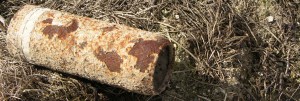
A projectile from the Great War lying in a field in France.
(P. Ferguson image, September 2005)
The Ones That Went Before
The King’s Speech has been an important film, allowing David Seidler, whose hero was the King, put pen to paper because they shared a struggle with words. And yet the man who brought these words to the film, and given the King his voice to us from the pages of history, has also found his voice. It is powerful message, a reminder that inspiration can be found in many places and in many things…
…As projectiles scattered across the fields of France and Flanders, they took with them whatever they encountered. They caused death, they took arms and legs and at times they took identity. It brings me to the soldiers of Sidcup. They are inspiring to me as they were brought back to us by a New Zealander named Dr. Harold Gillies at Queen Mary’s Hospital, Sidcup, England. Dr. Gillies rebuilt men by rebuilding their faces. These were the grievously injured of the First World War, when plastic surgery was in its infancy and finding the person within the scars a new science.
These soldiers in the trenches and across fields of service, or in the flames of war had lost faces, eyes, ears, jaws, teeth, cheekbones, noses, and other tissues. They were studied and photographed, rebuilt as best as they could be following painful surgeries with faces given to them, that no medal, no symbol of courage could equal. I recall when doing some research for the archives that I found an image of one soldier prior to his injuries. The doctors never knew what he looked like before they started but now so many years later and because of the dedication of the archives director, Dr. Bamji and his volunteers this soldier’s face has returned.
It is not always easy to face the uncomfortable but at the Gillies Archives the records of soldiers whose faces were lost to them, and to us, are inspirational. They are our better angels, the ones that let us know that war, despite its horrors, can provide inspiration for us to carry on. For every loss of sensation, loss of feeling, damaged nerve, or scar, there is a path leading to Gillies that allows us to rediscover the ones that went before.

A Great War iron shard. The pieces that tore into so many lives.
(P. Ferguson image, April 2007)
A special thanks to Dr. Bamji who allowed me to view this exceptional record of courage. At least one soldier of the 16th Battalion C.E.F. was a patient of Dr. Harold Gillies. For those interested in learning more about these soldiers visit:
Gillies Archives, Queen Mary’s Hospital
Project Facade, The Gillies Archives & The Faces of Battle Exhibition
Tags: Courage, Dr. Harold Gillies, Gillies Archives, Plastic Surgery, Queen Mary's Hospital, Sidcup, The King's Speech, Wounded
This entry was posted by pferguson
on Sunday, February 27th, 2011 at 9:50 pm and is filed under Our Thoughts.
You can follow any responses to this entry through the RSS 2.0 feed.
You can leave a response, or trackback from your own site.
About The Author

Paul has worked with the Paradigm Motion Picture Company since 2009 as producer, historian and research specialist. Paul first met Casey and Ian WIlliams of Paradigm in April 2007 at Ieper (Ypres), Belgium when ceremonies were being held for the re-dedication of the Vimy Memorial, France.
Paul's sensitivity to film was developed at an early age seeing his first films at RCAF Zweibrucken, Germany and Sardinia. Paul returned to Canada in 1967 and was captivated by David Lean's "Lawrence of Arabia" and "Bridge on the River Kwai". Over time Paul became increasingly interested in storytelling, content development, character, direction, cinematography, narration and soundtracks.
At the University of Victoria, Paul studied and compared Japanese and Australian film and became interested in Australian film maker Peter Weir and his film "Gallipoli" (1981). Paul was inspired when he learned Weir visited the beaches, ridges and ravines of the peninsula. "Gallipoli", the film, led Paul on many journeys to sites of conflict in England, France, Belgium, Holland, Germany, Malta, Hawaii, Gallipoli, North Macedonia and Salonika.
When Paul first watched documentary filmmaker Ken Burns, "The Civil War", Paul understood how his own experience and insight could be effective and perhaps influential in film-making. Combining his knowledge of Museums and Archives, exhibitions and idea strategies with his film interests was a natural progression.
Paul thinks like a film-maker. His passion for history and storytelling brings to Paradigm an eye (and ear) to the keen and sensitive interests of; content development, the understanding of successful and relational use of collections, imagery and voice. Like Paul's favorite actor, Peter O'Toole, Paul believes in the adage “To deepen not broaden.”
While on this path Paul always remembers his grandmother whose father did not return from the Great War and how his loss shaped her life and how her experience continues to guide him.



and Great Britain by signing the 1938 Munich agreement ‘ruined’ hopes
Links updated 2 May 2018. New link to Project Face and artist Paddy Hartley.
For those interested in more about Great War facial reconstruction you may wish to read Dr. Andrew Bamji’s fine book, “Faces From the Front”, Helion and Company, August 2017.